This chicken paella recipe is loaded with a medley of veggies and bold Spanish flavor. Endlessly impressive yet secretly easy, this is the one-pan chicken dinner you’ll add to your rotation!

Saffron-infused paella is the quintessential Spanish meal, whether it’s classic Seafood Paella, Chicken Paella, or its vermicelli noodle cousin Fideuà. With its impressive presentation and layered flavors of saffron, paprika, and sofrito, it seems reserved for special occasions.
But when you think about it, why not include paella in your standard rotation of homemade meals? Particularly this chicken paella recipe: With nothing to shuck or devein, it’s the definition of low-fuss.
After all, chicken paella is a one-pan meal complete with a starch, protein, and vegetables. The leftovers reheat well. You can customize it to use up the odds and ends in your fridge, and it’s ready in an hour, with just 40 minutes of hands-on time.
Table of Contents
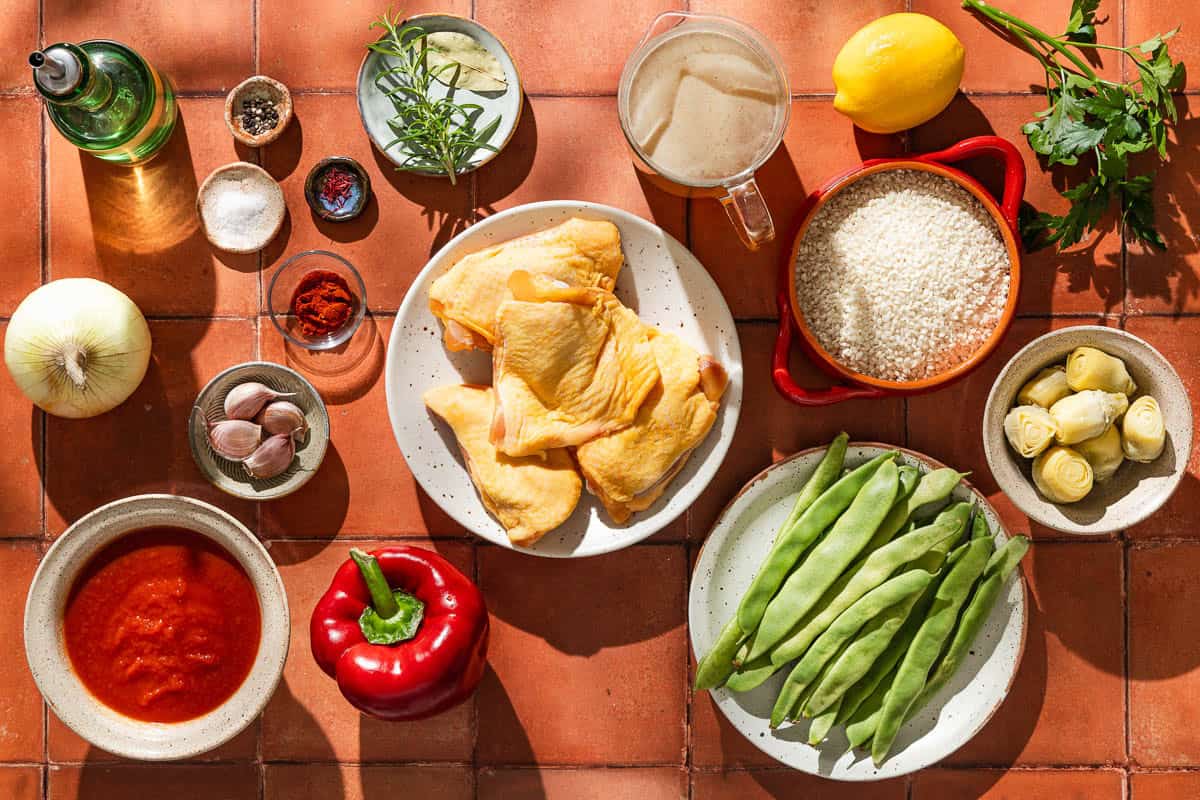
Is This Chicken Paella Recipe Traditional?
The truth is, even paella, a dish steeped in tradition, can be many things. There are all kinds of paella: seafood, meat, mixto (a mix of meat and seafood), and even vegetarian paella is common during Lent. Not only are there many varieties, but every cook, whether a home cook or a chef, will make it their way.
This chicken paella recipe celebrates that variety. I’ve taken a couple of shortcuts, but not enough to diverge from a classic paella. Some recipes start on the stove and finish in the oven. I prefer to cook the whole thing on the stove rather than preheat and transfer it to the oven. By cooking it on the stove, you’re more likely to get a flavorful crispy crust on the bottom of the rice, known as the prized socarrat.
Browning the chicken first allows you to crisp the skin. Then, the browned bits in the pan add extra flavor to the rice. Finally, the chicken braises in the stock along with the rice until it’s juicy without losing the crispness of the skin. That’s to say nothing of the tender green beans, tangy artichokes, and sweet red bell pepper!
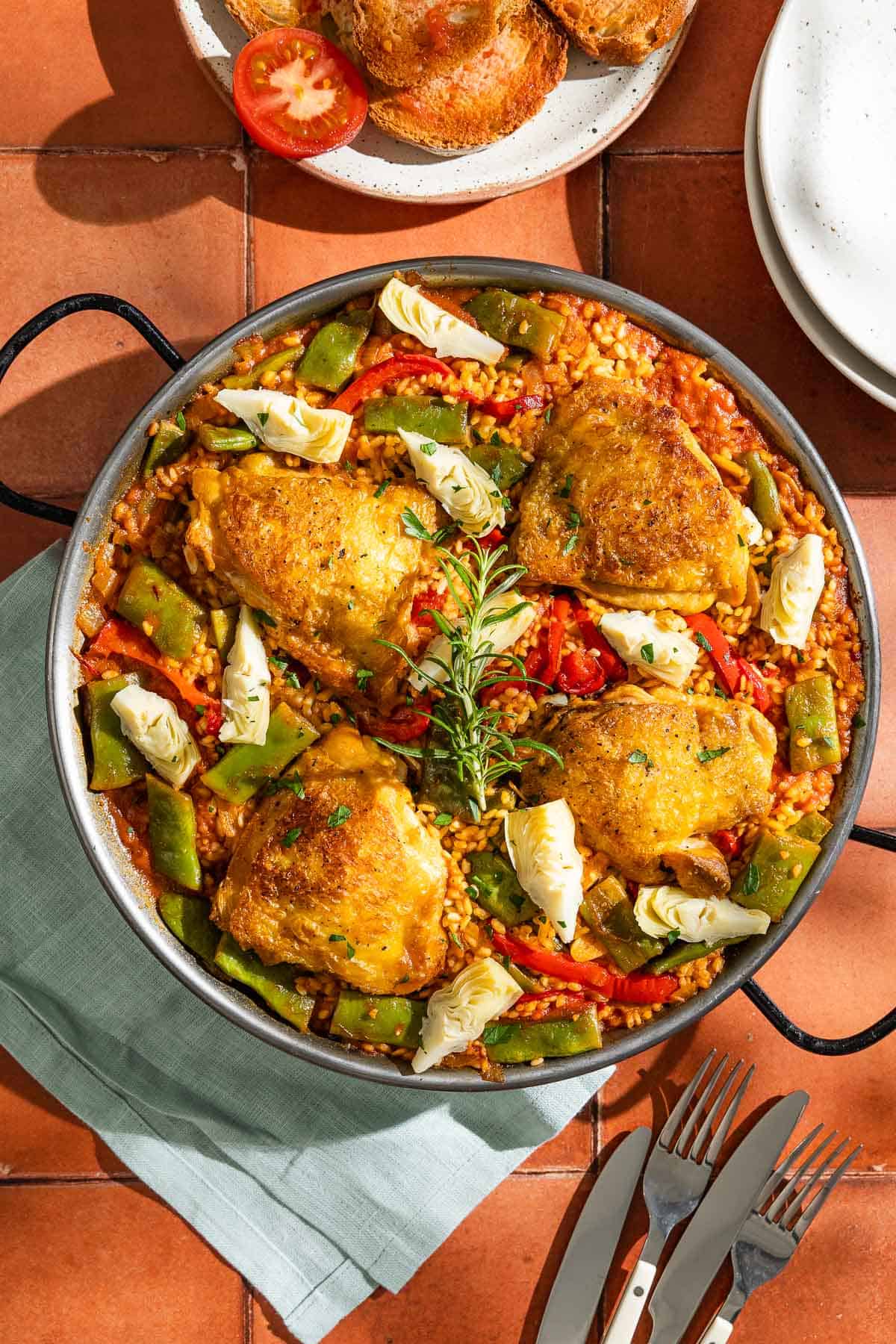
Ingredients for Chicken Paella
I like to add plenty of vegetables alongside the chicken. I prefer to use bone-in, skin-on chicken thighs. They get a crispy skin and then braise while the rice cooks until tender and juicy. Here’s what you’ll need:
- Extra virgin olive oil: I use good quality extra virgin olive oil to brown the chicken and sauté the vegetables. In this paella, I like a more intense, peppery olive oil like our Spanish Hojiblanca.
- Chicken thighs: I use bone-in skin-on chicken thighs and crisp the skin before it braises with the rice. You could also use a mix of thighs and drumsticks, or skinless boneless if you’d like, but adjust the cook time as they tend to cook faster.
- Onion: Onions are aromatic and after caramelizing slightly add sweetness to the rice. I prefer the boldness of yellow or white onions over red onions.
- Red bell pepper: Red bell peppers become sweet and fruity after caramelizing in the pan with the onions. You could use another bell pepper if you prefer.
- Romano beans: Romano beans or flat beans are long, flat green beans common in Spain that are sweet and get meltingly tender. If you can’t find them, you can substitute them with regular green beans or haricots verts.
- Garlic: Garlic becomes sweet, savory, and nutty when caramelized. Rather than mincing it, I prefer thin slices that keep their shape to happily discover later.
- Crushed tomatoes: Traditionally, fresh tomatoes are grated, leaving the skins behind, but I like to use good quality canned crushed tomatoes to save time and dishes without sacrificing any flavor.
- Paprika: Smoked paprika is made from peppers that are smoked, dried, and ground into a powder. The best Spanish paprika comes from La Vera and it adds a fruity, smoky flavor to the rice. Head over to our spice shop if you’re running low.
- Saffron: I use saffron threads and pinch them between my fingers to crush and bruise them before adding them to the paella. It turns the rice a beautiful gold and adds a complex floral flavor.
- READ MORE: What Is Saffron? An Essential Guide
- Paella rice: The best rice to use is bomba or calasparra, short, round varieties from Spain. If you can’t find those, you can use risotto rice like carnaroli or arborio.
- Chicken stock: Cooking the rice in chicken stock makes a richer and more flavorful paella. Use homemade stock or quality store bought.
- Aromatic herbs: I like to add a bay leaf and a rosemary sprig while cooking the rice. Rosemary can be overpowering, so I only add it for the last 10 minutes.
- Artichoke hearts: I use jarred artichokes, cutting them in half or quarters, depending on their size. Since they’re already cooked, I add them at the end while the cooked rice rests.
- Parsley: While you could get away with skipping the garnish of parsley, I love the fresh herbaceous flavor it adds.
- Lemon: Don’t skip the lemon. A squeeze of lemon juice over the plate of paella makes a huge difference.

How to Make Chicken Paella
The trick for a good paella is to avoid stirring the rice, or you’ll release starch making it sticky. Paella takes about an hour from start to finish, but it’s a one-pan meal with a hands-off break while the rice is cooking. Here’s how to make it:
- Brown the chicken: In a large paella pan or a large heavy-bottomed pan set over medium heat, add 2 tablespoons of olive oil. Season both sides of 4 chicken thighs generously with salt and pepper. Once the oil shimmers place the chicken in the pan skin side down and cook without moving or flipping until the skin releases from the pan and turns golden brown, about 8 minutes. Flip and brown the other side for 3 minutes. Transfer the chicken to a plate and set aside. (The chicken will not yet be fully cooked at this point but will braise later.)
- Cook the vegetables: Add 1 diced onion and cook, stirring occasionally with a wooden spoon, until it begins to soften, about 5 minutes. Add 1 sliced bell pepper and continue to cook, stirring occasionally, until it begins to brown, about 5 minutes. Add 1/2 pound sliced green beans and cook, stirring, for 5 minutes. Add 4 sliced garlic cloves and cook until fragrant, about 1 minute.

- Add the tomato and spices: Add 1 cup canned crushed tomato, 1 teaspoon smoked paprika, and 3/4 teaspoon salt. Add 1/4 teaspoon saffron threads, crumbling them a bit by pinching between your thumb and fingertips. Stir to combine, then cook until the tomato reduces and the pan is almost dry, about 2 minutes.

- Flavor the rice: Add 1 1/2 cups Paella rice and cook, stirring to coat, for 1 to 2 minutes. Use the wooden spoon to distribute the rice and vegetables in an even layer in the pan. Nestle in the chicken with the skin side up, along with any accumulated juices from the plate.

- Cook the rice: Pour in 3 cups chicken stock and add 1 bay leaf. From this point forward, do not stir the rice. Once the stock comes to a simmer, reduce the heat to low. Cook for 10 minutes, adjusting the heat as necessary to maintain a simmer.
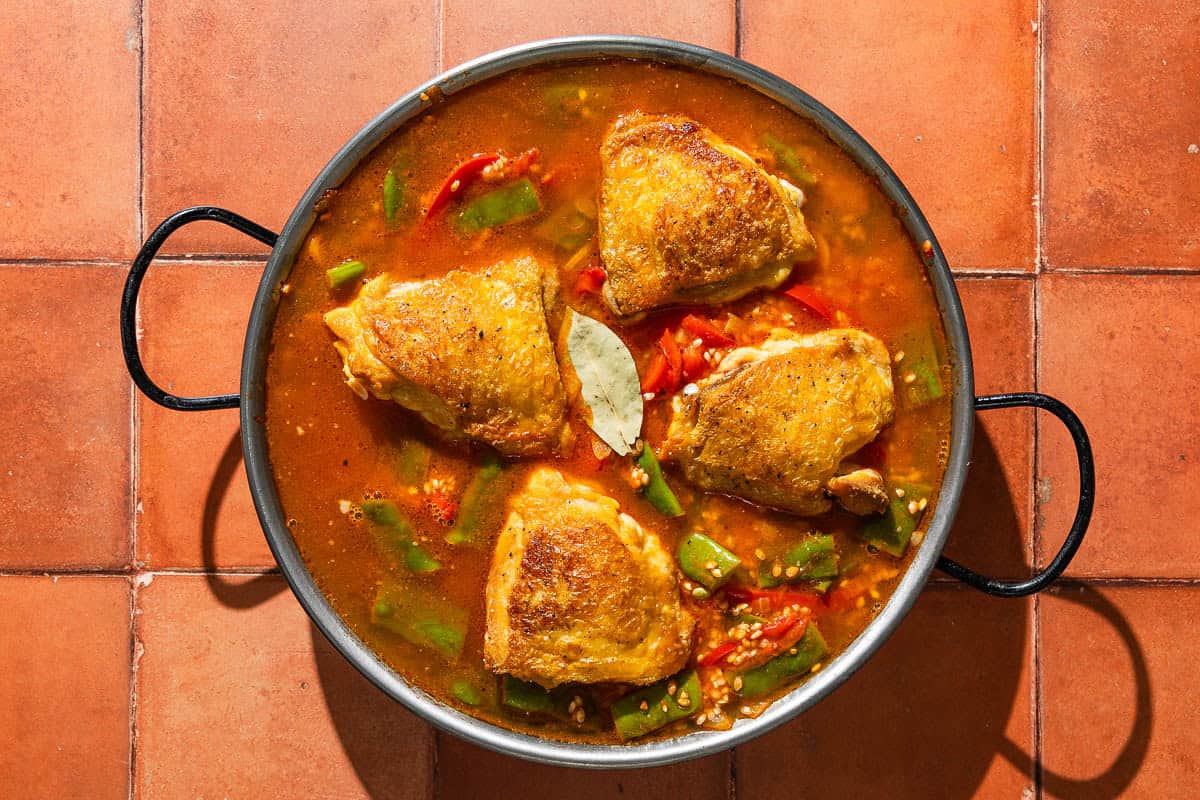
- Finish the rice: Add a sprig of rosemary and continue to cook until all of the stock has been absorbed and the rice is tender, about 10 to 15 minutes longer. If the rice still isn’t cooked, add another 1/2 cup of stock and continue to cook until absorbed, then check again.
- Rest: Take the pan off the heat and add the artichoke hearts. Let the paella sit, uncovered, for 5 minutes before serving.
- Finish, garnish, and serve: Remove the bay leaf and the sprig of rosemary. Sprinkle with parsley and serve immediately with lemon wedges. If you’re lucky, you may have a layer of crispy rice stuck to the bottom of the pan. Be sure to scoop it up!

Swaps and Substitutions
While paella is a dish rooted in tradition, every home cook and chef will inevitably make it differently. This means you have free range to make this chicken paella recipe your own. I don’t always use the same combination of vegetables. I might use a green pepper instead of a red pepper if that’s what I have. Sometimes I cook with wine if I have a bottle that’s been open for a couple of days. Other days I make it more indulgent by adding chorizo. Here are a few swaps and substitutions that you can make:
- Add wine: Many cooks use a splash of white wine for the acidity it adds. Substitute 1/2 cup of white wine for 1/2 cup of the chicken stock.
- Add Spanish chorizo: I don’t add much, usually just one diced link along with the onion for the spicy, garlicky flavor.
- Mix up the veggies: You don’t have to stick with the vegetables I list here. Asparagus, mushrooms, or chopped cooked spinach are just a few substitution ideas.
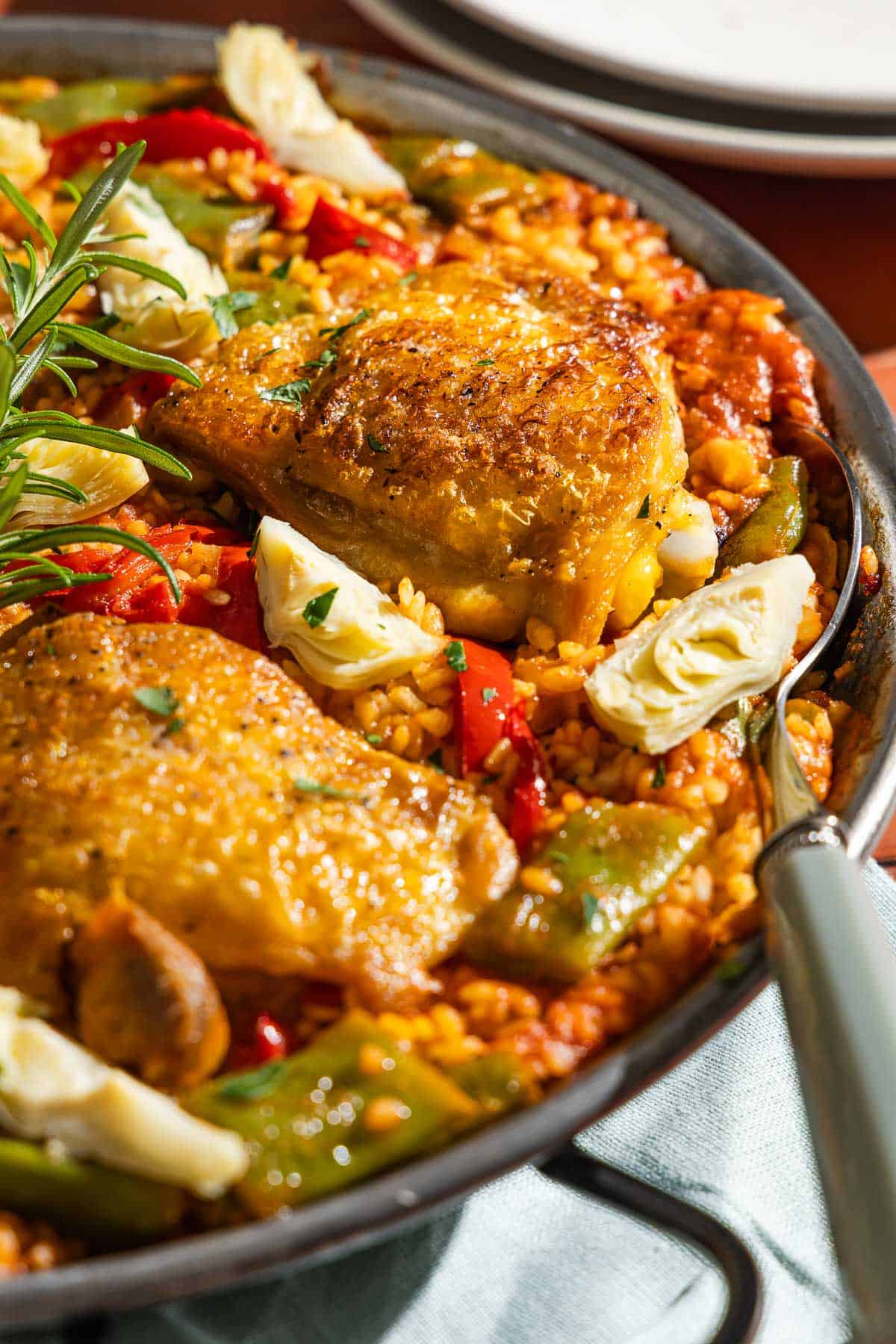
What to Serve with Chicken Paella
Paella is already a satisfying meal on its own. But if you’re looking to round out the menu, I’d start with a salad or a cold soup. For cold soups, you can’t go wrong with classic Gazpacho, but my favorite is the creamier Salmorejo. For salad, a refreshing Cucumber Tomato Salad goes beautifully with this chicken paella recipe.
I rarely have a meal without Pan con Tomate to start. And there’s usually a bowl of olives on the table too, though you could elevate things with this Olive Salad.
I like to pair a dry Spanish white wine with this paella, or a glass of Sangria for a big lunch with friends.
If it’s a gathering, a dessert like Crema Catalana is a definite crowd-pleaser. But fruit is the most common dessert after a big meal in Spain. Try this Fruit Salad, called macedonia de fruta here in Spain.
More One Pan Chicken Dinners
Browse all Mediterranean recipes.
Visit Our Shop
Easy Chicken Paella
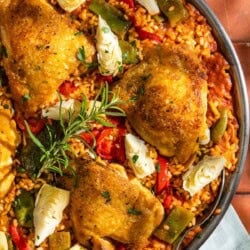
Ingredients
- 2 tablespoons extra virgin olive oil
- 4 bone-in, skin-on chicken thighs
- Kosher salt
- Freshly ground black pepper
- 1 onion, finely diced
- 1 red bell pepper, sliced into thin strips
- 1/2 pound (230g) romano beans or green beans, trimmed and cut into 1-inch pieces
- 4 garlic cloves, thinly sliced
- 1 cup canned crushed tomatoes
- 1 teaspoon smoked paprika
- 1/4 teaspoon saffron threads
- 1 1/2 cups Paella rice, bomba, Calasparra, carnaroli, arborio
- 3 cups chicken stock
- 1 bay leaf
- 1 rosemary sprig
- 1/2 cup artichoke hearts, halved or quartered
For Serving
- 3 tablespoons flat-leaf parsley, minced
- 1 lemon, sliced into wedges
Instructions
- Brown the chicken: Heat the olive oil in a large paella pan or a large heavy-bottomed pan over medium heat. Season both sides of the chicken generously with salt and pepper. Place the chicken in the pan skin side down and cook without moving or flipping until the skin releases from the pan and turns golden brown, about 8 minutes. Flip and brown the other side for 3 minutes. Transfer the chicken to a plate and set aside. (The chicken will not yet be fully cooked at this point but will braise later.)
- Cook the vegetables: Add the diced onion and cook, stirring occasionally with a wooden spoon, until they begin to soften, about 5 minutes. Add the sliced red pepper and continue to cook, stirring occasionally, until they begin to brown, about 5 minutes. Add green beans and cook, stirring, for 5 minutes. Add the sliced garlic and cook until fragrant, about 1 minute.
- Add the tomato and spices: Add the crushed tomato, paprika, and 3/4 teaspoon salt. Add the saffron, crumbling the threads a bit by pinching them between your thumb and fingertips. Stir to combine, then cook until the tomato reduces and the pan is almost dry, about 2 minutes.
- Flavor the rice: Add the rice and cook, stirring to coat, for 1 to 2 minutes. Use the wooden spoon to distribute the rice and vegetables in an even layer in the pan. Nestle in the chicken skin side up, along with any accumulated juices from the plate.
- Cook the rice: Pour in the stock and add the bay leaf. From this point forward, do not stir the rice. Once the stock comes to a simmer, reduce the heat to low. Cook for 10 minutes, adjusting the heat as necessary to maintain a simmer.
- Finish the rice: Add the sprig of rosemary and continue to cook until all of the stock has been absorbed and the rice is tender, about 10 to 15 minutes longer. If the rice still isn’t cooked, add another 1/2 cup of stock and continue to cook until absorbed, then check again.
- Rest: Take the pan off the heat and add the artichoke hearts. Let the paella sit, uncovered, for 5 minutes before serving.
- Finish, garnish, and serve: Remove the bay leaf and the sprig of rosemary. Sprinkle with parsley and serve immediately with lemon wedges. If you’re lucky, you may have a layer of crispy rice stuck to the bottom of the pan. Be sure to scoop it up!
Notes
- Shop this recipe: Visit our shop to browse quality Mediterranean ingredients including the olive oil, saffron, and smoked paprika used in this recipe.
- You can make this recipe your own. Add chorizo, white wine, or swap in the veggies you have on hand.
Nutrition
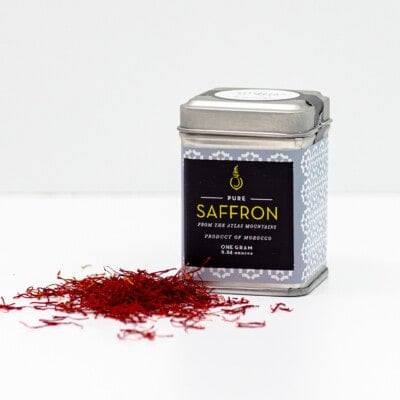
Try Our All Natural Saffron
Moroccan saffron threads, sourced from the Atlas Mountains.





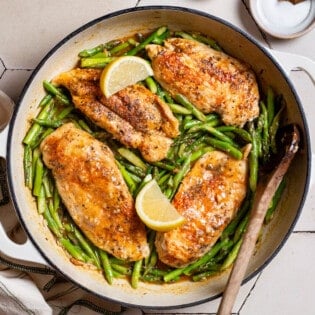
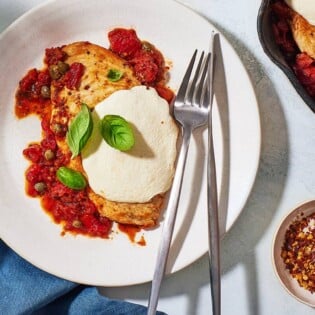
Delicious
So so nice every mouthful being a flavour fiesta. Used a 20 inch/50cm paella pan which easily took 8 good thighs. (4 people)
Used risotto rice which was fine just didn’t agitate it to much and even had some rice left which was gently nuked in the micro and served with plain poached fish as a small lunch(2 people) with the rice flavours maturing overnight plain fish was the order of the day.
Doing it again with chicken breast and a ‘chicken powder’ stock.so intense, with times adjusted as appropriate and all on a single ring Cadac gas camping cooker (paella pan comes with it)
Better than anything i’ve had in Spain.
Should I cover the pot while summer in the rice?
Hello! There’s no need to cover the pot while simmering here.